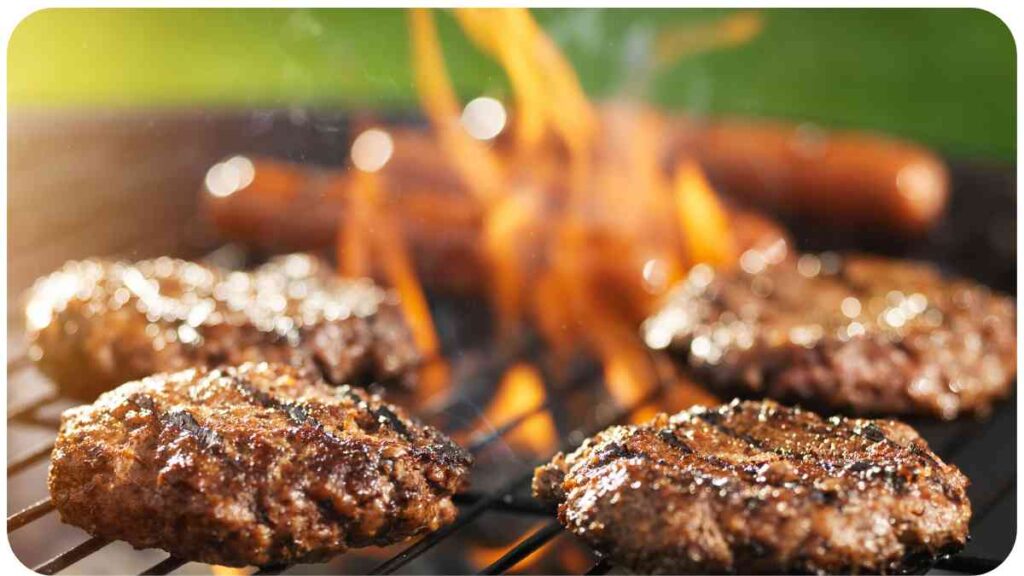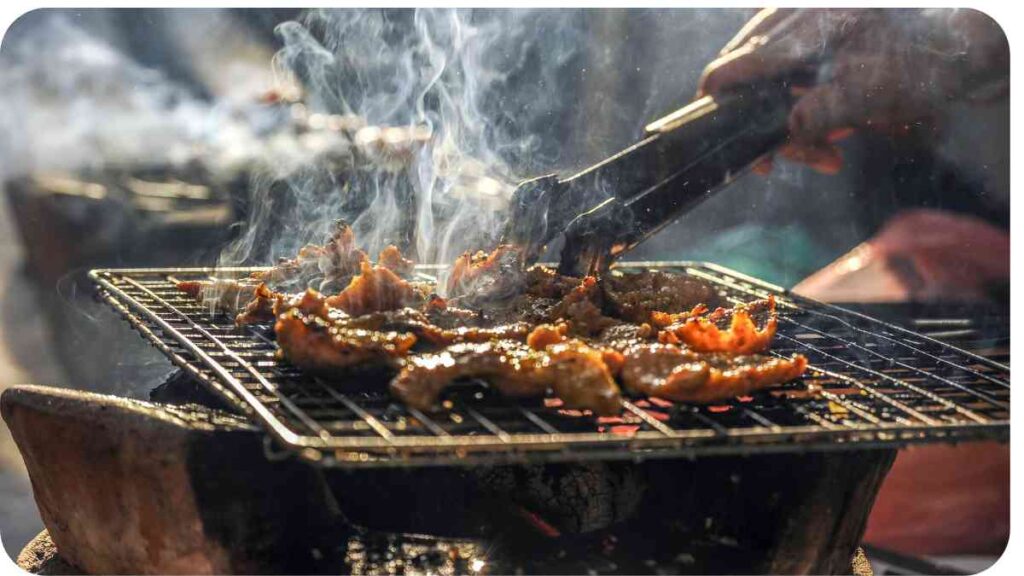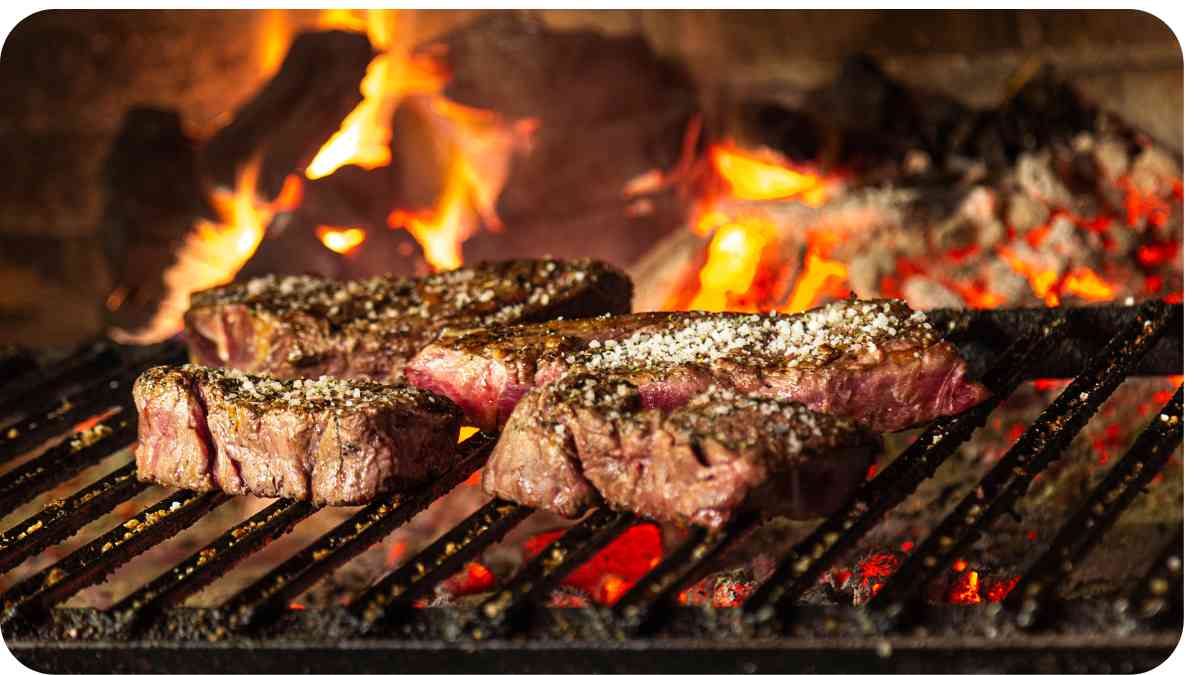Grilling a perfect steak isn’t just a culinary task; it’s a blend of art and science. If you’re a grill enthusiast looking to transcend the ordinary and attain steak excellence, you’re in the right place. In this guide, we’ll unravel the mysteries behind achieving the perfect grilled steak on a Traeger grill.
From the intriguing science that unfolds on the grill grates to practical techniques refined through personal expertise, you’re about to embark on a flavorful journey.
Key Takeaways |
|---|
| 1. The Maillard reaction creates flavorful grill marks and complex tastes. |
| 2. Marbling within meat enhances tenderness and explosion of flavors. |
| 3. Traeger grills use wood pellets for smoky authenticity and precise control. |
| 4. Choose cuts like ribeye and strip for optimal grilling results. |
| 5. Resting steak allows juices to redistribute for even juiciness. |
| 6. Achieve grill marks with diagonal placement and rotation technique. |
| 7. Meat thermometers and the touch test aid in determining doneness. |
| 8. Experiment with wood pellets for varied smoke-infused flavors. |
| 9. Salvage overcooked steak through thin slicing and flavorful accompaniments. |
| 10. Elevate grilling with insider tips like reverse searing and compound butter. |
The Science Behind Grilling
The Maillard Reaction: Bringing Flavors to Life
At the heart of extraordinary grilled steaks lies the Maillard reaction, a scientific marvel that transforms the mundane into the delectable. When amino acids and reducing sugars in your steak interact at elevated temperatures, a symphony of colors, aromas, and flavors dance on your taste buds. This reaction, akin to caramelization, delivers those irresistible grill marks and complex flavors that make your steak memorable.
“For a well-grilled steak, follow this grill maintenance checklist. It ensures your Traeger grill is in top shape, guaranteeing the perfect sear and flavor.”
The Role of Marbling in Flavor and Tenderness
As a seasoned griller, I’ve learned that marbling isn’t just pretty patterns within the meat; it’s the gateway to steak euphoria. Intramuscular fat weaves throughout the muscle, basting it from within during the cooking process. This results in unparalleled tenderness and an explosion of flavors that aficionados crave. Opt for well-marbled cuts like ribeye or New York strip for a juicy, melt-in-your-mouth experience.
Understanding the Traeger Grill
How Traeger Grills Work
In the realm of pellet grills, Traeger stands as a paragon of innovation. These grills operate on wood pellets, infusing your steak with a mesmerizing smokiness. A thermostat maintains your desired temperature by regulating the pellet auger and fan speed. This consistency is a game-changer, allowing you to focus on perfecting your grilling technique.
Advantages of Using a Traeger Grill

With a Traeger at your disposal, your grilling prowess elevates. The precise temperature control mitigates the risk of overcooking, while hardwood pellets impart complexity to your steak’s flavor profile. The versatility to smoke, grill, bake, roast, and braise opens a world of culinary exploration.
“Understanding the science of grilling is essential. Learn how to achieve consistent results for the perfect steak every time you fire up your Traeger grill.”
Selecting the Perfect Steak
The Cuts that Excel on the Grill
Not all steaks are created equal on the grill. Optimal cuts include ribeye, New York strip, porterhouse, and T-bone. Their marbling and thickness ensure they can handle the grill’s intense heat without sacrificing juiciness.
The Influence of Aging on Meat Quality
Aging isn’t just for fine wines; it’s a steak game-changer too. Dry aging allows enzymes to break down muscle fibers, intensifying flavor and tenderness. Wet aging, on the other hand, enhances meat through vacuum-sealed magic. Whichever route you choose, your taste buds will thank you.
Prepping for Grilling Success
Seasoning: Beyond Salt and Pepper
Seasoning is your steak’s passport to flavor nirvana. While salt and pepper are the foundation, don’t be afraid to experiment with rubs and herbs. A simple blend of garlic powder, onion powder, and smoked paprika can take your steak to new heights.
Don’t let errors ruin your grilling experience. Find solutions for Pit Boss pellet grill errors to ensure smooth cooking on your Traeger grill.”
To Marinade or Not to Marinade?
Marinades can enhance flavors and tenderize meat, but they require finesse. Acidic marinades can lead to over-tenderization, turning your steak into mush. Opt for marinades with herbs, oils, and minimal acids to strike the perfect balance.
Achieving the Ideal Grilling Temperature
Searing vs. Indirect Heat
The battle between searing and indirect heat is real, and the Traeger grill handles both with finesse. Start with a sear over high heat to lock in juices, then shift to indirect heat for thorough cooking. Refer to the Traeger temperature chart for precision.
Optimal Temperature Guidelines
For rare, aim for an internal temperature of 120°F (49°C); medium-rare, 130°F (54°C); medium, 140°F (60°C); medium-well, 150°F (66°C); and well done, 160°F (71°C). But remember, personal preference reigns supreme.
“Choosing the right grill brand matters. Explore the comparison of Nexgrill vs. Weber to make an informed decision when upgrading your grill equipment.”
Mastering Grill Marks and Crust
Techniques for Picture-Perfect Grill Marks
Grill marks aren’t just superficial; they’re seared-in flavor highways. Achieve those covetable crosshatches by placing the steak diagonally across the grill grates, then rotating it 90 degrees halfway through each side’s cooking time.
The Secrets of a Flavorful Crust
A robust crust ensures every bite is an explosion of taste. The key? Pat your steak dry before grilling to minimize steam interference. This encourages the Maillard reaction and imparts that caramelized, umami-rich exterior.
The Art of Flipping
How Many Times Should You Flip?
As a grill virtuoso, my recommendation is simple: flip once. Flipping incessantly disrupts the Maillard reaction and delays grill marks. Allow each side to sizzle and sing its flavorful song.
Precise calibration is key. Check out the comprehensive guide on Weber grills calibration to ensure your Traeger grill cooks your steaks to perfection every time.”
Timing and Intervals for Best Results
For a 1-inch steak, grill for about 3-4 minutes per side for medium-rare, adjusting for your preferred doneness. Use Traeger’s “keep warm” feature while resting to ensure your steak doesn’t lose its heat.
Smoke Infusion and Flavor Enhancement

Wood Selection for Different Flavors
With Traeger’s array of hardwood pellets, you’re the flavor conductor. Opt for mesquite for robustness, cherry for sweetness, or hickory for a classic touch. Experimentation is your ticket to culinary revelation.
Controlling Smoke Intensity
Too much smoke can overwhelm, while too little leaves you wanting. Traeger’s “Smoke” setting infuses just the right amount. Remember, subtlety often trumps excess in the realm of smoke.
Monitoring Doneness Accurately
Using Meat Thermometers Effectively
Technology meets tradition with meat thermometers. Insert the probe into the thickest part of the steak, away from bone. This avoids false readings and ensures your steak emerges perfectly cooked.
The Touch Test: A Chef’s Intuition
Veteran grillmasters often rely on touch to gauge doneness. A firm press on the steak mimics well-done, while a gentle touch resembles rare. It’s a tactile dance of experience and instinct.
Why Resting Is Non-Negotiable
Patience is a virtue, especially in the realm of grilling. Resting allows the juices that migrated to the surface during cooking to redistribute evenly throughout the meat. This means every bite is succulent and satisfying.
Duration and Tenting Method
Resting times vary, but a general rule is 5-10 minutes for small cuts and up to 20 minutes for larger ones. Tent your steak loosely with aluminum foil to retain warmth without sacrificing the coveted crust.
Slicing and Serving Like a Pro
Knife Selection and Technique
A chef is only as good as their tools, and the right knife is your ticket to steak-slicing prowess. Opt for a sharp, long-bladed knife. Slice against the grain for tender, melt-in-your-mouth bites.
Presentation and Accompaniments
Elevate your culinary creation with thoughtful presentation. A sprinkle of fresh herbs adds vibrancy, while a drizzle of compound butter or balsamic reduction offers a luxurious touch. Pair your steak with wine or a refreshing salad for a harmonious meal.
Troubleshooting Grilling Hiccups
Dealing with Flare-Ups
Flare-ups are the uninvited guests of grilling. If flames dance too close, move the steak to a different spot or temporarily turn down the heat. Remember, vigilance is your best friend here.
Salvaging Overcooked or Undercooked Steak
We all have mishaps. If your steak leans towards the overcooked side, consider slicing it thinner to minimize the impact. For undercooked steak, finish it in the oven at a low temperature to reach your desired doneness without sacrificing texture.
Elevating Your Steak Game: Tips from the Grill Masters
Insider Tips for Grill Perfection
- Reverse Searing: Start with low heat to cook the steak evenly, then finish with a high-heat sear for the ultimate contrast.
- Brine and Dry Rub: Brining keeps the steak juicy, while a dry rub adds an extra layer of flavor.
- Compound Butter: A pat of compound butter on your rested steak melts into a luscious sauce.
Learning from Experience: Stories from the Grill
My journey to steak mastery was marked by trial and error. I’ve resurrected overcooked steaks, marveled at perfectly executed grill marks, and even had a few flare-up scares. Each experience is a stepping stone to expertise, turning a hobby into an art form.
Conclusion
And there you have it – a voyage through the art and science of grilling the perfect steak on a Traeger grill. From the chemistry behind the Maillard reaction to the finesse of achieving impeccable grill marks, you’re now equipped with the knowledge to transform a simple piece of meat into a culinary masterpiece. Remember, while the science sets the stage, it’s your passion and practice that steal the show. So, fire up your Traeger, embrace the sizzle, and let your inner grill virtuoso shine. Happy grilling!
Further Reading
For those hungry for more knowledge about grilling the perfect steak and delving into the science behind it, here are some resources worth exploring:
- Traeger Forum: The Science Behind Grilling the Perfect Steak A community discussion diving into the scientific intricacies of grilling steak to perfection on a Traeger grill.
- Smithsonian Magazine: The Science Behind Grilling the Perfect Steak An illuminating article from Smithsonian Magazine that uncovers the science and innovation behind achieving the ideal grilled steak.
- Traeger: How to Grill Steak Traeger’s official guide to grilling steak, providing step-by-step instructions and expert tips for mastering the art of grilling.
FAQs
How does the Maillard reaction contribute to the flavor of a grilled steak?
The Maillard reaction, triggered by the interaction of amino acids and sugars at high temperatures, is responsible for the enticing color, aroma, and taste that define a perfectly grilled steak.
What are the advantages of using a Traeger grill for steak preparation?
Traeger grills offer precise temperature control and the use of hardwood pellets for authentic smoky flavor. Their versatility allows for various cooking methods, resulting in exquisite steak creations.
Which steak cuts are recommended for grilling?
Cuts like ribeye, New York strip, porterhouse, and T-bone excel on the grill due to their marbling and thickness, resulting in a juicy and flavorful outcome.
How can I determine the doneness of my steak without overcooking?
Utilizing a meat thermometer is an effective way to ensure accurate doneness. Alternatively, you can employ the touch test, where the steak’s firmness provides cues about its level of cooking.
What’s the significance of resting a grilled steak before serving?
Resting allows the steak’s juices to redistribute, ensuring even distribution of flavor and tenderness. This step is crucial to deliver a satisfying dining experience.
Can I salvage an overcooked steak?
Yes, an overcooked steak can be salvaged. Thinner slicing can minimize the impact, and adding a flavorful sauce or compound butter can enhance its appeal.
How can I achieve perfect grill marks on my steak?
To achieve those covetable grill marks, place the steak diagonally on the grates, then rotate it 90 degrees halfway through cooking each side.
What’s the role of marbling in steak quality?
Marbling, the intramuscular fat within a steak, contributes to its tenderness, juiciness, and flavor. Well-marbled cuts are favored for grilling due to their enhanced taste and texture.
What are some insider tips for elevating my steak grilling game?
Consider reverse searing, using brines and dry rubs, and experimenting with compound butters. These techniques can take your steak to the next level in terms of flavor and presentation.

Hi there! I’m Hellen James, and I’m a grilling enthusiast. I’ve been grilling for years, and I absolutely love it. I love how it brings people together and how you can feed your family with just a few minutes of work.

